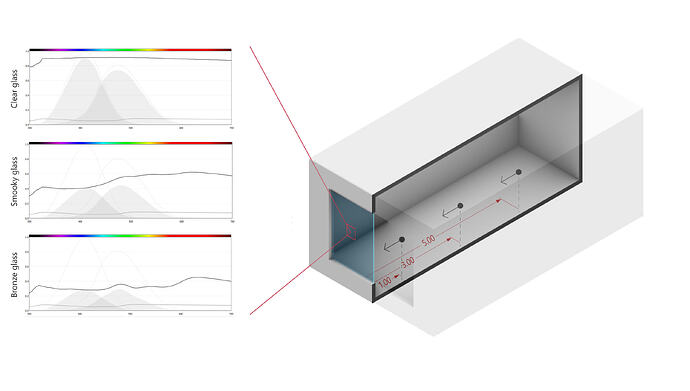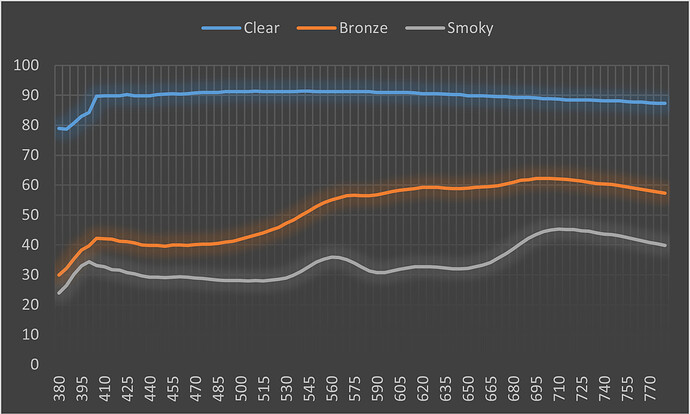Hello everyone,
I am aware that the spectral simulation capability is still under development; however, I am trying to use it in my project. I built a scaled room 743 (1/10) and conducted spectral measurements (location: 35°47’49.4"N 51°24’48.7"E) at three depths with several different glasses using a spectrometer.
Here, I have provided the transmission data for three of the glasses that I measured with the spectrophotometer .
I performed spectral simulation based on the material information of the model (rad and mat files here) in the ALFA plugin and Radiance 6.0a, but the results are not encouraging 
In order to compare the spectral output of Radiance with ALFA, given that simulating 81 channels is currently not possible with -co as I understand, I modified one of the components of Lark plugin that was used to convert 9 channels into 400 channels so that I could also convert the output of 20 or 24 channels to 400 channels. (CSV file 380-780 5nm Exp,ALFA and Rad6.0)
At shallow depths, the performance of Radiance is close to the measurements I took, and at greater depths, the performance of ALFA is also close. I changed every parameter that I thought relevant, but I have not figured out where I went wrong (ipynb file)
Any suggestions would be greatly appreciated.
1 Like
For deeper position try something like this, adjust ab, ad and lw until you see the values stabilize.
tr_params = pr.SamplingParameters(
ab = 8,
aa = 0,
ad = 16384,
lw = 0.00001,
cs = 20,
co = True,
)
If you have sky measurements, we recently introduced -L dirnorm difhor option to genssky, where dirnorm and difhor are for direct normal and diffuse horizontal illuminance. Running with this will give you a better integrated values. This option is not in pyradiance yet, but will be soon.
3 Likes
Hi Taoning,
Thank you
I have also performed simulations with similar and even higher settings, but there is still a significant difference compared to ALFA and Exp.
Has there been any comparison between the Radiance spectral simulation and other tools or exprimental measurements up to this point? ( except this [article] (https://publications.ibpsa.org/proceedings/bs/2021/papers/bs2021_30583.pdf))
I wasn’t aware of the new genssky feature. Thank you for letting me know! I’ll test it.
I am expecting quite a bit difference (>50% maybe) between your original one and the one I shared above. If you are not seeing any difference then there is something wrong with the process.
1 Like
Make sure you set -lr -12 or so. Positive values of -lr are associated with low accuracy when -aa is 0
1 Like
Hi dear Greg,
After a long time, today I see the edited version of your response. On that day, I tried with -lw and got:
rtrace: fatal - zero ray weight in Russian roulette (obviously  )
)
Also, I tested it now with -lr -12, but it didn’t have much effect. Now I figured out that aa = 0 was the main problem, and if set it to 0.1 or any other value except 0, there is absolutely a better result.
Best regards,
Soushiyant
OK, so long as you are happy. The error you got happens with a negative -lr value and a -lw value of 0, which is not a supported combination since it can lead to infinite recursion.
Cheers,
-Greg
![]()


